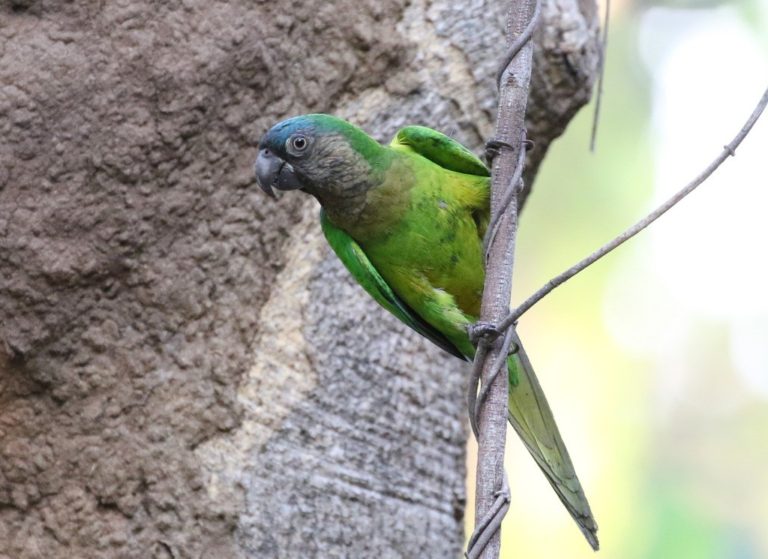Birdfinding.info ⇒ The Colombian form of Brown-throated Parakeet is common across most of its range. Especially numerous along the coast from the mouth of the Río Sinu to Riohacha, including Isla de Salamanca National Park, Los Flamencos Wildlife Sanctuary, and the urban areas of Cartagena, Barranquilla, and Santa Marta. The introduced population on Isla San Andrés is often conspicuous at sites such as the botanical garden.
“Gray-throated Parakeet”
Eupsittula pertinax aeruginosa
Endemic to Colombia and western Venezuela, where it inhabits various semiopen habitats—especially xeric scrub, dry forest, mixed agricultural zones, and settled areas.
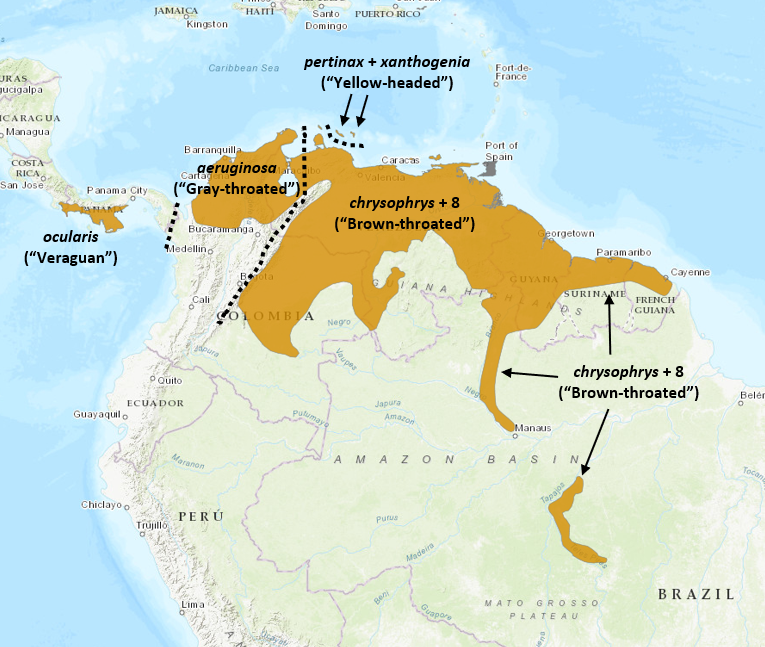
Approximate distribution of “Gray-throated Parakeet” relative to other forms of Brown-throated. Parakeet. © BirdLife International 2018
Occurs nearly throughout the Caribbean lowlands of Colombia, west to the Río Sinu Valley, east to the Maracaibo Basin of western Venezuela, and south through the Medellín, Cauca, and Magdalena Valleys to the vicinities of Cali and Neiva.
Apparently expanding its range southward and upslope as it adapts to urbanization and some agricultural habitats. Either occasional or recently established around Bogotá and on the Pacific slope around Buenaventura.
An introduced population is apparently well-established on Isla San Andrés, and at least one flock has also been reported from Isla Providencia.
Identification
Resembles “typical” Brown-throated Parakeet but with an entirely grayish-brown face, throat, and chest. Unlike the other forms, “Gray-throated” lacks any yellow or orange coloration on the face, and it tends to show a blue flush on the crown, strongest on the forecrown.
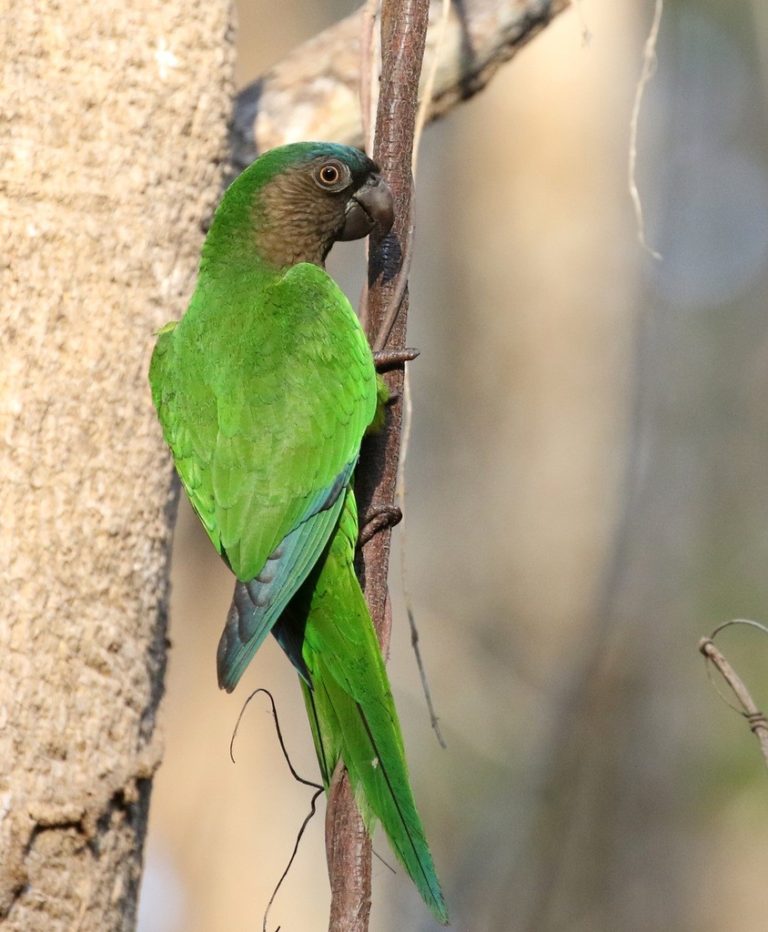
“Gray-throated Parakeet”, E. p. aeruginosa, showing grayish, scaly-textured face and bluish forecrown. (La Elisa, Magdalena, Colombia; January 25, 2020.) © Matthew Grube
The grayish-brown plumage of the face, throat, and chest has a distinctly scaled appearance. The lores and immediate forehead are often darker, sometimes blackish. A contrasting eyering typically appears gray or whitish, but can also appear bluish.

“Gray-throated Parakeet”, E. p. aeruginosa. (Guamal, Magdalena, Colombia; December 27, 2020.) © Sergio Barrios
Otherwise mostly grass-green above and pale yellowish-green below. The belly sometimes has an orange or reddish wash.
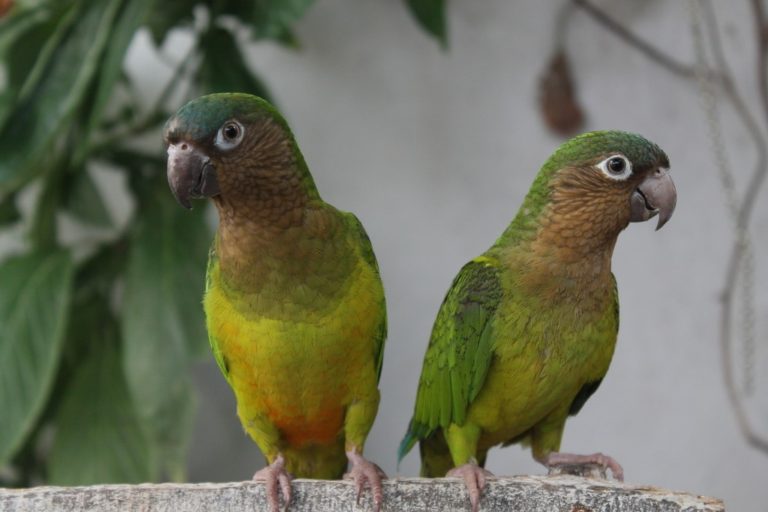
“Gray-throated Parakeet”, E. p. aeruginosa. (Paluato, Galapa, Atlántico, Colombia; May 1, 2020.) © Jeir Ortega Galvan

“Gray-throated Parakeet”, E. p. aeruginosa. (Taganga, Magdalena, Colombia; January 24, 2019.) © Graham Sorenson
The flight feathers are extensively blue in varying shades, from aqua to royal blue.
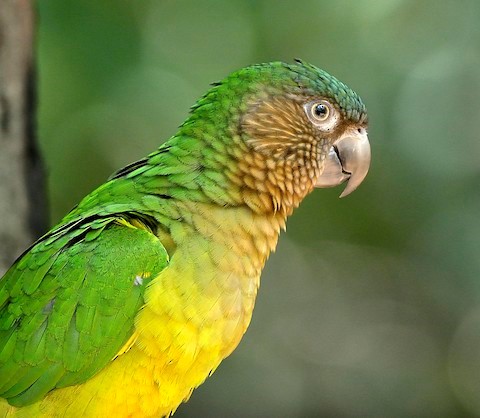
“Gray-throated Parakeet”, E. p. aeruginosa, with a whitish eyering. (Caucasia, Antioquia, Colombia; September 2017.) © John Jairo Betancur Salinas
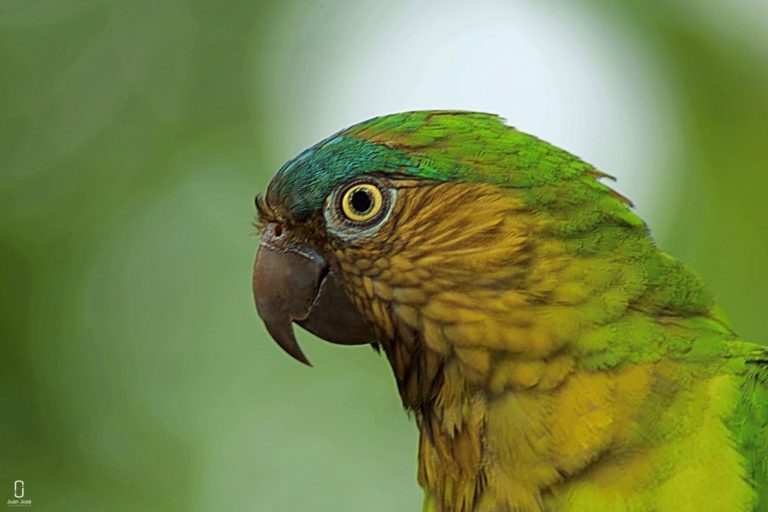
“Gray-throated Parakeet”, E. p. aeruginosa, with atypically vivid coloration, including olive or yellowish brown face, throat, and chest, pale-bluish eyering, and turquoise crown. (Santa Cruz de Lorica, Córdoba, Colombia; May 7, 2018.) © Juan José López Negrete
Immatures are mostly green with olive face, throat, and chest, and a whitish or grayish eyering. As they mature, the olive turns more grayish-brown.
Many immatures have a pale-gray forehead (which might be the source of the putative subspecies griseipecta, which was described as a population that resembles aeruginosa but occupies the Río Sinú drainage and has a pale-gray forehead).

“Gray-throated Parakeet”, E. p. aeruginosa, with a pale grayish face and forehead—possibly an immature. (Santuario de Fauna y Flora Los Flamencos, La Guajira, Colombia; July 30, 2017.) © Eric VanderWerf
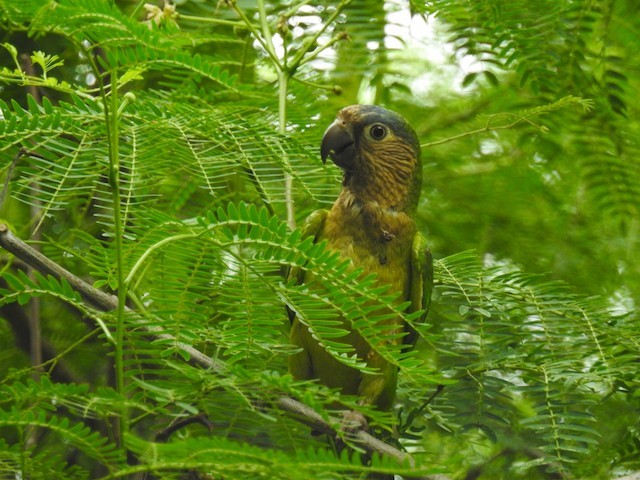
“Gray-throated Parakeet”, E. p. aeruginosa, possibly an immature. (San Andrés Botanical Garden, Isla San Andrés, Colombia; May 20, 2017.) © Carlos Ao Martínez T.
Notes
Polytypic form consisting of two recognized subspecies, aeruginosa and griseipecta, which are collectively one of four (or so) potentially distinct forms of Brown-throated Parakeet (pertinax). However, it might be more appropriately regarded as monotypic, as the validity of griseipecta as a subspecies separate from aeruginosa appears dubious.
For a discussion of the taxonomy of the Brown-throated Parakeet complex, see Distinguishing Features: Has the Diversity of Brown-throated Parakeets Been Overlooked?
See below for a comparison of “Gray-throated Parakeet” with other forms of Brown-throated Parakeet.
Cf. Other Brown-throated Parakeets. The “Gray-throated Parakeet” is a distinctive, isolated form of Brown-throated Parakeet. It differs from the other populations in having grayer, “scalier” plumage on the face, neck, and throat, and more blue on the forecrown (possibly linked to age or sex). “Gray-throated” differs from all other Brown-throated populations in that the adults lack orange plumage on the face. Immatures of several other populations (including those adjacent to “Gray-throated” on both the east and west) also lack orange plumage on the face, and thus resemble adult “Gray-throated” and appear to be indistinguishable from immature “Gray-throated”.
Additional Photos of “Gray-throated Parakeet”
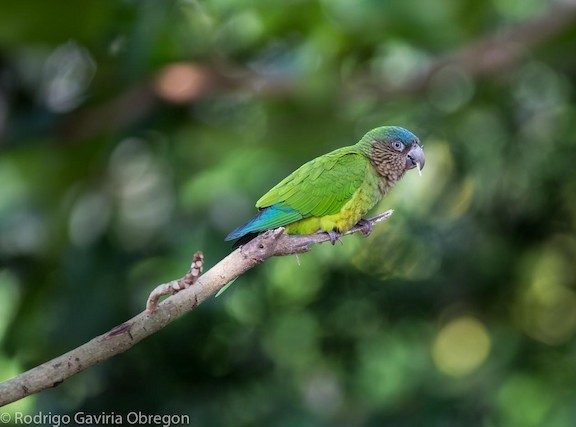
“Gray-throated Parakeet”, E. p. aeruginosa, showing scaly-textured grayish face, blue forecrown, and blue on flight feathers. (Torrelavega Wildlife Rescue, Antioquia, Colombia; May 2, 2017.) © Rodrigo Gaviria Obregon

“Gray-throated Parakeet”, E. p. aeruginosa. (San Antero, Córdoba, Colombia; May 3, 2019.) © Andrés Posada
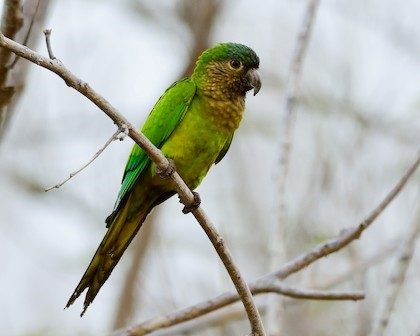
“Gray-throated Parakeet”, E. p. aeruginosa. (Barranquilla, Atlántico, Colombia; January 26, 2020.) © Ad Konings
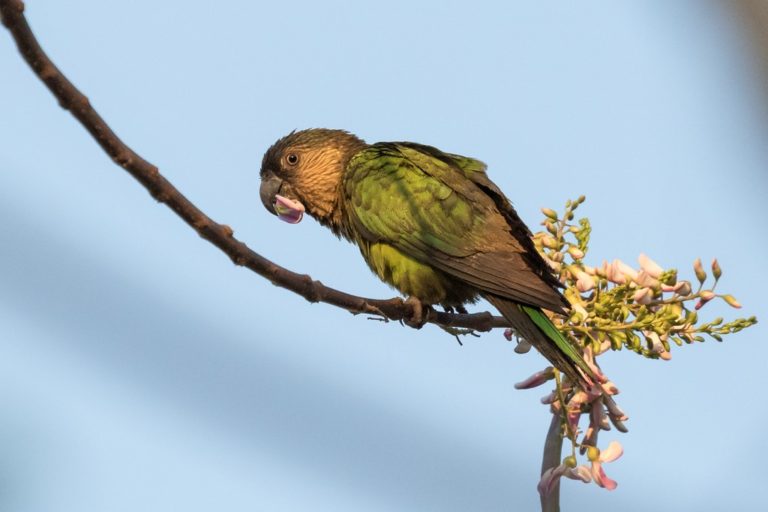
“Gray-throated Parakeet”, E. p. aeruginosa, showing scaly-textured, grayish face, throat, and chest. (Isla de Salamanca National Park, Atlántico, Colombia; February 19, 2018.) © Ken Chamberlain
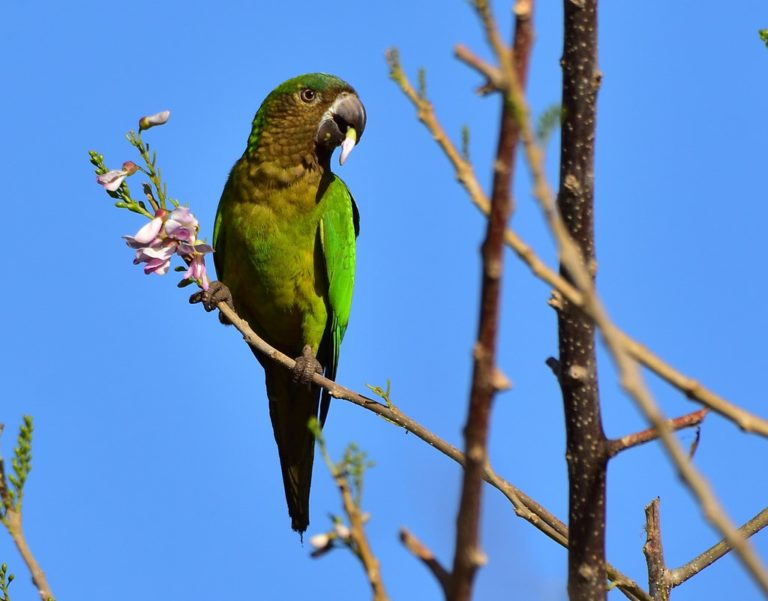
“Gray-throated Parakeet”, E. p. aeruginosa. (Barranquilla, Atlántico, Colombia; January 19, 2020.) © Ad Konings
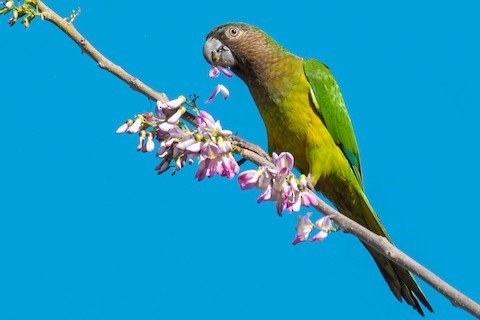
“Gray-throated Parakeet”, E. p. aeruginosa. (Barranquilla, Atlántico, Colombia; January 19, 2020.) © Don Danko
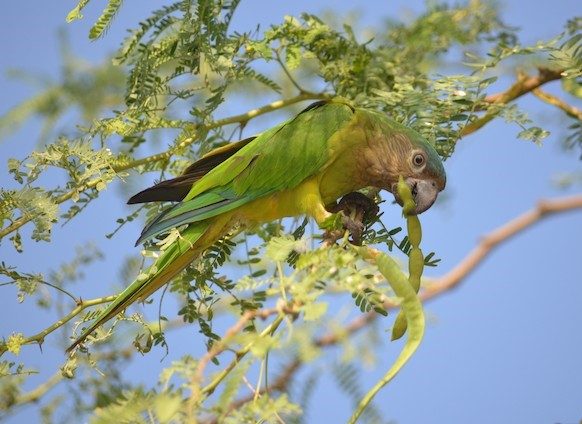
“Gray-throated Parakeet”, E. p. aeruginosa. (Taganga, Magdalena, Colombia; July 28, 2017.) © Ben Phalan

“Gray-throated Parakeet”, E. p. aeruginosa, apparently a pair bonding. (Cartagena, Colombia; March 15, 2020.) © navtombros
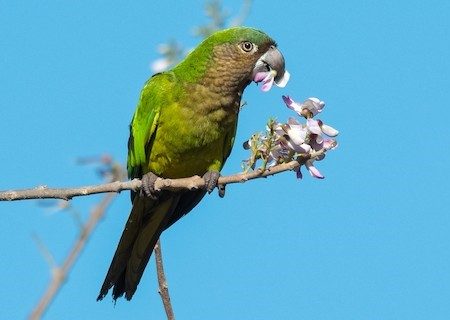
“Gray-throated Parakeet”, E. p. aeruginosa. (Barranquilla, Atlántico, Colombia; January 19, 2020.) © Don Danko
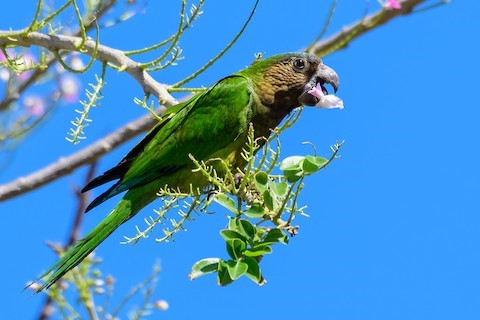
“Gray-throated Parakeet”, E. p. aeruginosa. (Barranquilla, Atlántico, Colombia; January 18, 2020.) © Don Danko

“Gray-throated Parakeet”, E. p. aeruginosa (or possibly griseipecta, based on the location), showing strong demarcation between grayish chest and green lower breast. (Cerete, Córdoba, Colombia; June 20, 2021.) © José Jorge Mendez
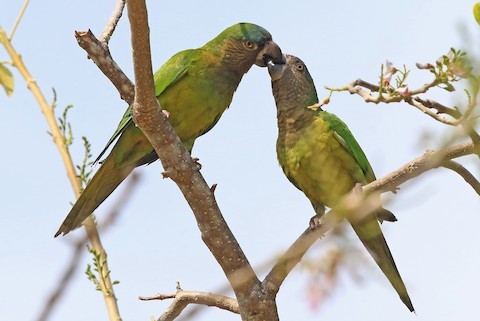
“Gray-throated Parakeet”, E. p. aeruginosa, apparently either pair-bonding or possibly an adult feeding an immature. (Isla de Salamanca National Park, Atlántico, Colombia; January 18, 2018.) © Phillip Edwards

“Gray-throated Parakeet”, E. p. aeruginosa (or possibly griseipecta, based solely on the location, although there doesn’t appear to be any feature to distinguish it from aeruginosa). (San Marcos, Sucre, Colombia; December 19, 2019.) © Ruber Ledesma Ruiz
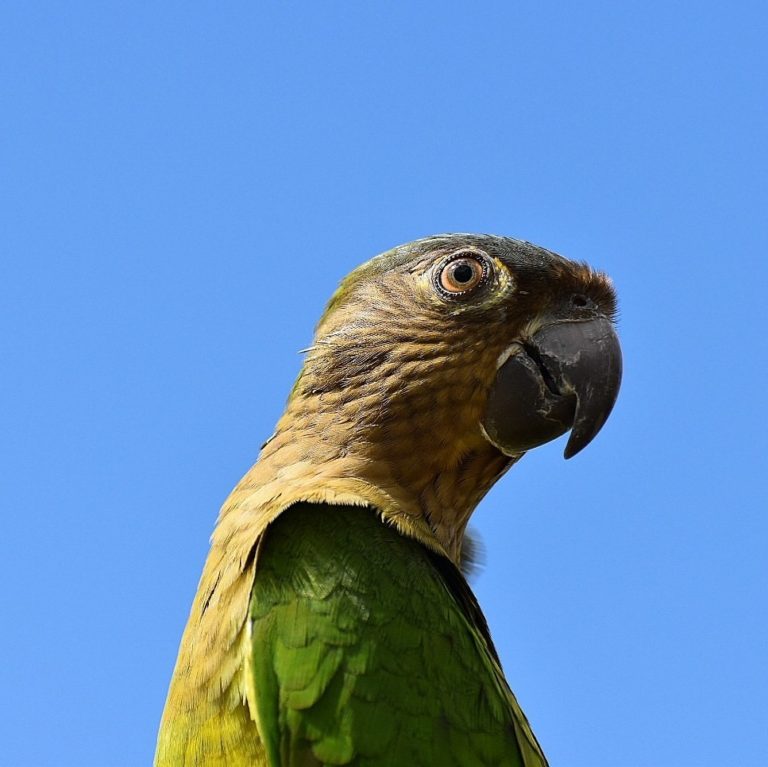
“Gray-throated Parakeet”, E. p. aeruginosa, close-up showing scaly texture of facial feathering. (Puerto Parra, Santander, Colombia; January 26, 2018.) © Herson Triana Mendoza
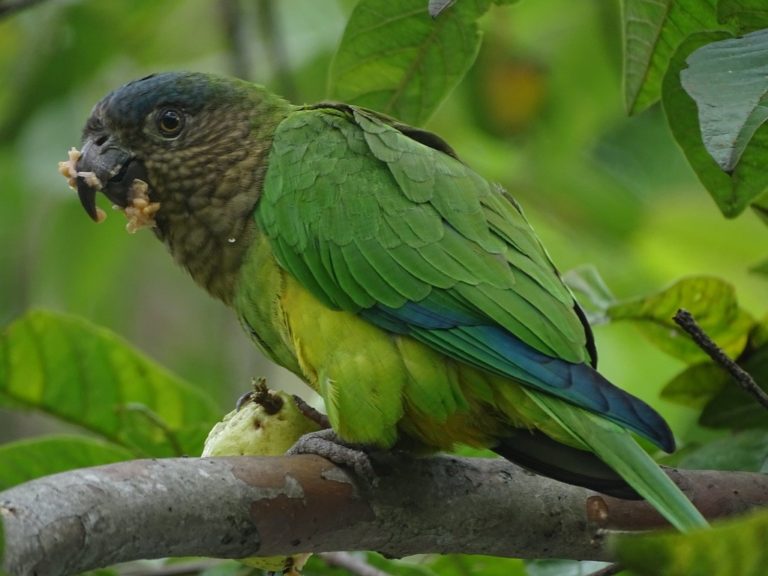
“Gray-throated Parakeet”, E. p. aeruginosa, appearing well-fed. (Medellín, Colombia; November 7, 2018.) © Esteban Villa Restrepo
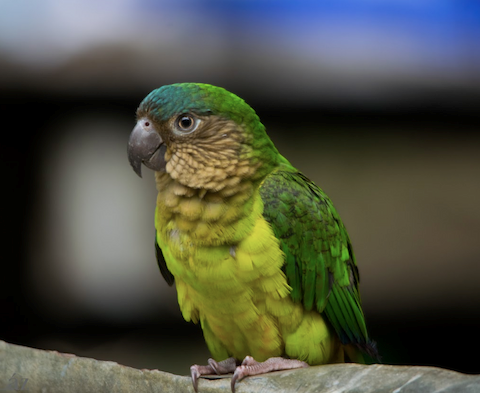
“Gray-throated Parakeet”, E. p. aeruginosa. (Reserva Luriza, Atlántico, Colombia; September 17, 2017.) © Jossie Esteban Lázaro Romero
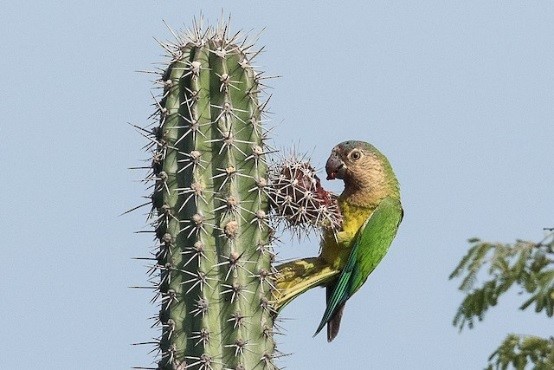
“Gray-throated Parakeet”, E. p. aeruginosa, with a pale grayish face. (Santuario de Fauna y Flora Los Flamencos, La Guajira, Colombia; July 30, 2017.) © Eric VanderWerf
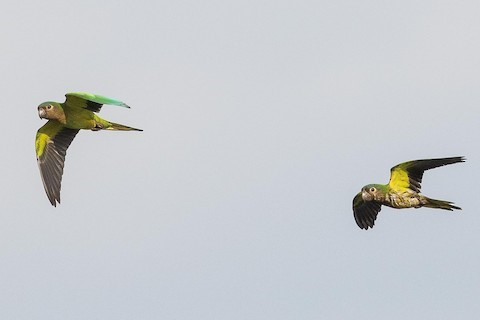
“Gray-throated Parakeets”, E. p. aeruginosa, in flight, showing underwing pattern. (Cari-Cari, La Guajira, Colombia; July 29, 2017.) © Eric VanderWerf
References
Ascanio, D., G.A. Rodriguez, and R. Restall. 2017. Birds of Venezuela. Christopher Helm, London.
BirdLife International. 2018. Eupsittula pertinax. The IUCN Red List of Threatened Species 2018: e.T22685745A131917543. https://dx.doi.org/10.2305/IUCN.UK.2018-2.RLTS.T22685745A131917543.en. (Accessed August 18, 2021.)
eBird. 2021. eBird: An online database of bird distribution and abundance. Cornell Lab of Ornithology, Ithaca, N.Y. http://www.ebird.org. (Accessed August 18, 2021.)
Forshaw, J.M. 2010. Parrots of the World. Princeton University Press, Princeton, N.J.
Juniper, T., and M. Parr. 1998. Parrots: A Guide to Parrots of the World. Yale University Press.
Kirwan, G.M., A. Levesque, M. Oberle, and C.J. Sharpe. 2019. Birds of the West Indies. Lynx Edicions, Barcelona.
McMullan, M., and T. Donegan. 2014, Field Guide to the Birds of Colombia (Second Edition). Fundación Proaves de Colombia, Bogotá.
Meyer de Schauensee, R., and W.H. Phelps, Jr. 1978. A Guide to the Birds of Venezuela. Princeton University Press.
Xeno-Canto. 2021. Brown-throated Parakeet – Eupsittula pertinax. https://www.xeno-canto.org/species/Eupsittula-pertinax. (Accessed August 18, 2021.)
